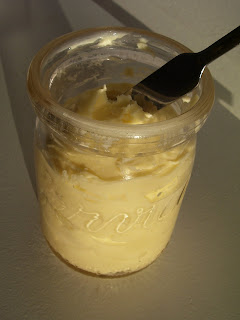
Santa did not bring me worms for Christmas like I had hoped, but he did bring me a gift that keeps on giving. Keeps on giving him bread. I got a shiny new bread machine.
I just started baking my own bread a few months ago with lackluster results. I had grand aspirations of eliminating plastic bread bags, saving money, and impressing my family with my domestic skill while making the house smell great. Instead I got oddly shaped-hard-dense loaves, entire days lost to "bread making", bread shortages, and emergency runs to the store to buy bread.
So when I unwrapped my new toy on Christmas day I thought my prayers had been answered. Yes! Now we can enjoy some real bread. I am still not sure if the gift was for me or hubby. Either way it does not vouch well for my bread baking artistry. I had such high hopes for this machine. You put the ingredients in and take the bread out. Perfect! Nothing for me to mess up.
Then explain this. Is it a chef's hat? A giant popover? What? It certainly cannot be a loaf of bread from my new magic machine. Can it? Damn. I have made three different loaves and none were good. I had better luck the old fashioned way. What am I doing wrong? Is there some secret bread baking society that I am banned from, a gluten gene I lack, or am I just doomed to forever eat mass produced bread out of a plastic bag? The only somewhat success that has come out of this is a batch of cinnamon rolls and butter.

Yes, butter. Since I was having no luck on the bread front I thought I would try to at least make its topping good. Homemade butter, which I never thought to be something I was capable of, is surprisingly easy to make. All you need is cream and a means to agitate it. A stand mixer works great.

Fifteen minutes later whipping at medium-high to high speed and it transforms from cream to butter.





Pour the butter and liquid off through a sieve, but save the liquid!! Not only did I make butter, but buttermilk as well. It is a two for one deal. The buttermilk will be used for pancakes or biscuits later.

Rinse the butter under cold water until it runs clear. Press out excess moisture and transfer to container of your choice.

One pint of cream will yield one cup of buttermilk and about one cup of butter (2 sticks). I used some cheap cream I had left over from Christmas to make this batch, but the least expensive organic cream I can find sells for $2.95 a pint. The organic butter I buy is $4.99 a pound. Organic buttermilk is $3.39 a quart. I save over $2.00 on the butter by making my own, but actually end up spending more on the buttermilk. In the end I gain a financial savings of 79 cents. Not worth the time to make your own? Consider this, in an effort to reduce packaging I started buying premium organic grass-fed local butter packaged in one paper wrapper. It retails for $6.99 a pound. Ouch! Now my savings jump to $2.79.
The real benefit for me is the package savings. I can go from two cardboard packages and four wax paper wrappers when buying the less expensive option; or, one cardboard package and one paper wrapper with the pricey stuff, down to one cardboard container when making my own. I think I can even find cream in glass at my coop. Even less waste!
I find it amusingly enjoyable and oddly empowering to make my own butter and buttermilk. Now if I could just get that bread thing figured out...
So when I unwrapped my new toy on Christmas day I thought my prayers had been answered. Yes! Now we can enjoy some real bread. I am still not sure if the gift was for me or hubby. Either way it does not vouch well for my bread baking artistry. I had such high hopes for this machine. You put the ingredients in and take the bread out. Perfect! Nothing for me to mess up.
Then explain this. Is it a chef's hat? A giant popover? What? It certainly cannot be a loaf of bread from my new magic machine. Can it? Damn. I have made three different loaves and none were good. I had better luck the old fashioned way. What am I doing wrong? Is there some secret bread baking society that I am banned from, a gluten gene I lack, or am I just doomed to forever eat mass produced bread out of a plastic bag? The only somewhat success that has come out of this is a batch of cinnamon rolls and butter.

Yes, butter. Since I was having no luck on the bread front I thought I would try to at least make its topping good. Homemade butter, which I never thought to be something I was capable of, is surprisingly easy to make. All you need is cream and a means to agitate it. A stand mixer works great.

Fifteen minutes later whipping at medium-high to high speed and it transforms from cream to butter.





Pour the butter and liquid off through a sieve, but save the liquid!! Not only did I make butter, but buttermilk as well. It is a two for one deal. The buttermilk will be used for pancakes or biscuits later.

Rinse the butter under cold water until it runs clear. Press out excess moisture and transfer to container of your choice.

One pint of cream will yield one cup of buttermilk and about one cup of butter (2 sticks). I used some cheap cream I had left over from Christmas to make this batch, but the least expensive organic cream I can find sells for $2.95 a pint. The organic butter I buy is $4.99 a pound. Organic buttermilk is $3.39 a quart. I save over $2.00 on the butter by making my own, but actually end up spending more on the buttermilk. In the end I gain a financial savings of 79 cents. Not worth the time to make your own? Consider this, in an effort to reduce packaging I started buying premium organic grass-fed local butter packaged in one paper wrapper. It retails for $6.99 a pound. Ouch! Now my savings jump to $2.79.
The real benefit for me is the package savings. I can go from two cardboard packages and four wax paper wrappers when buying the less expensive option; or, one cardboard package and one paper wrapper with the pricey stuff, down to one cardboard container when making my own. I think I can even find cream in glass at my coop. Even less waste!
I find it amusingly enjoyable and oddly empowering to make my own butter and buttermilk. Now if I could just get that bread thing figured out...























19 comments:
Don't give up on the bread baking. I make all of our bread, but it took me a while (and a number of not-so-great loaves)to get the technique down.
I'd recommend trying a recipe from either The Bread Bible or Local Breads. Both have very detailed instructions that are easy to follow, as well as some handy troubleshooting tips. I found both books at my public library.
Don't give up on the bread baking. I make all of our bread, but it took me a while (and a number of not-so-great loaves)to get the technique down.
I'd recommend trying a recipe from either The Bread Bible or Local Breads. Both have very detailed instructions that are easy to follow, as well as some handy troubleshooting tips. I found both books at my public library.
It really does take some time and then one day it'll all click and your bread will be perfect every time. Have you tried the tutorials at The Fresh Loaf?
http://www.thefreshloaf.com/lessons
That's how I learned.
I would also keep trying with your bread maker. I started out using Breadmachine yeast (which was fine with my old breadmaker) and discovered that my bread machine only liked Red Star Active yeast. My loaves wouldn't rise unless I used the Red Star Active yeast.
Your instruction manual should have a little troubleshooting section (mine does) that tells you what went wrong. If I remember correctly, I think the issue you are describing has something to do with the liquid/flour ratio. Maybe you have too much liquid? If you want me to look this up... drop me a line at my blog. I do not have the same bread maker you have but the symptoms should be the same anyways.
I consider myself inept in many ways and somehow, I can make bread. (That's meant to inspire you somehow!) I don't make all the bread for my family since I'm working almost full time but I long to be able to someday.
Thanks so much for the funny and honest post, along with those wonderful photos. We're glad you joined us this week for Thrifty Green Thursday!
When I first started baking bread, just two months ago, I was terrified. I thought of yeast as a terrifying beast and rising would be abominable. And then I tried Foodie Farm Girl's "beyond easy beer bread" and I was hooked. Here's the link to her original post about it: http://foodiefarmgirl.blogspot.com/2005/11/beyond-easy-beer-bread.html
And a link to my related post: http://bentofoodbear.blogspot.com/2008/12/thanksgiving-kitchen-adventures.html
If you're having a terrible time with yeast breads, maybe taking a step back from the yeast would make it easier; solution: beer! My first few loaves turned out dense and yucky because I was kneading/mixing too much. Mix as little as possible and you'll come out with better results.
Also, make sure your yeast isn't dead, your baking powder isn't expired, and you're using just the right amount of salt. (You can proof yeast by mixing it with lukewarm water and sugar or honey and waiting until it bubbles. No bubbles = dead yeast).
Giant popover--ha! Maybe you can post your recipe and we can help figure out what went wrong. I usually have pretty good luck with my own breadmaking attempts. (I should really get back to it; I hate the plastic bag waste, too!)
A lot of things can affect the way your bread turns out. I am not sure why your bread machine bread ended up like that. I thought those were fool proof. Guess not!
On the bright side, your butter looks excellent!
I use my bread machine on the dough setting and then bake it in the oven. I don't like the weird shape or the crunchy crust from the bread machine pan. Plus, it's easier to take credit for a loaf right out of the oven! ~ib mommy
and the reason i mentioned that is...... sometimes the dough hits the top of the lid and deflates. i knew i had a point there somewhere
Greeen Sheeep - I think you're adding just a touch too much liquid or just a touch too much honey or sugar. The yeast is working too quickly and then falls back on itself during baking. Try adding just the bare minimum of liquid (the recipe usually gives us a range of how much liquid to add) and listen to the kneading process. If the dough "clunks" around the machine and makes the machine rattle on the counter, add liquid a tablespoon at a time until it forms a proper dough ball. Conversly, you don't want to see the kneader spin around the bottom of the dough with more moisture than the rest of the dough. My loaves from the bread machine always fell in until I learned this. I'm off to check out the rest of your blog. Happy weekend:)
Thanks everyone for the tips and encouragement!
Gabriel & Dorothy - I will be looking for those books when I return my Square Foot Gardening book to the library.
Heather - I used the Fresh Loaf when I was doing it all by hand. Now I need some kind of bread machine lessons. I wonder if there a website for that?
psuklinkie - thanks for the link! I definitely had live yeast. I think they were a bit over active.
Pirate Farmer - Hey I didn't know you changed your name!? I like the header on your new blog. I am going to try the same recipe again today, only finish it off in my own oven. And yes, it did rise too much, hit the lid and collapse.
Suzan - my recipe called for a specific amount of liquid, no range. The machine was a bit clunky during the kneading, but the dough was still sticky after the first rise. Isn't that an indicator to add more flour?
Here is what I did.
Recipe:
1 1/2 cups water, 80-90 degrees
3 tablespoons unsalted butter, 1/2-inch pieces at room temperature
3 teaspoons sugar or honey
1 1/2 teaspoons salt
4 cups bread flour
1/4 cup nonfat dry milk
2 teaspoons yeast
Place all ingredients, in order listed in machine.
I made a 2 pound loaf on light crust. I think the cycle was 3 1/2 hours long. I took the temperature of the water and used the amounts listed. I did use bread flour, honey, and Hodgson Mill active dry yeast out of the refrigerator. The package says it is great for electric bread machines. It was quite warm inside the machine throughout the cycles. The viewing window fogged up. After the first rise I removed the paddle and noticed the dough felt weird. I have only been baking bread for a short time so I'm not really sure how dough is supposed to feel, but this was different than any of my other loaves. It was soft, squishy, smooth yet sticky and warm! Like a balloon filled with warm water. I thought it might need more flour, but let it be. During the second rise it got really big! It nearly hit the lid. Then it collapsed. I noticed a large bubble far too late. Tried to deflate it but the crust had already set. When the dough finished it was really tall, sunken, very light and fluffy with large air pockets. There was a hollow if you will in the center of the loaf. It tasted fine, but was awkward to cut and extremely crumbly when toasted.
sometimes if you try making the simplest bread recipe from scratch the old-fashioned way you get more of a feel for how things are supposed to look/develop .. i would recommend it. it's easy! :^)
I don't have a stand mixer, no room in this house (thank god it's only for a few years) but I may take a trip out to my mom's house and use her's. We have talked about having a day to just bake up double batches of somethings from scratch.
I love your butter calculations. I'm always interested in whether or not I'm saving money, but can't be bothered to work it out. Now I'm definitely ready to give butter a try.
Don't forget to put a value on the fun experience of making your own bread and butter, not to mention the compliments you'll get from guests. Those make it all worth it.
Beth Hensperger's Bread Lover's Bread Machine Cookbook is my bread bible. I've been making on average little more than a loaf per week (a variation on the honey wheat recipe) for nearly a year. They've always come out great. I do stop the machine at the end of the second rise and move the dough to a bread pan. It finishes rising on the fireplace and then bakes in the oven. Bread machine square loaves just didn't work for sandwiches. Excellent sticky bun recipe in the book, too.
I'm using Fleishman's Rapid Rise Yeast. Beth's got some recommendations on types of yeasts and how to adjust the recipes to accommodate them.
Bread dough that's got the right balance of flour and moisture, and has been kneaded sufficiently, should "sound and feel like a baby's bottom." At least, that's what my mother always said.
Sorry, I mangled the link to Beth's book. Try this one.
when you say cream, do you mean whipping cream or regular? What percent milk fat is it? I used whipping cream to make butter, but there was no buttermilk leftover, so I'm guessing you used regular cream like people would put in their coffee?
Jen - I've used whipping cream before. I don't know what the percentages were, but I've always had buttermilk leftover...
Christina - Thanks for the link to the bread machine cookbook. I was wondering if there was one specifically for this. I will surely check it out. I'm starting to finish my loaf in my own oven now. The shape is much better and easier to fit in the toaster.
Jen - The batch in the post was made with heavy whipping cream, but I have also made it with heavy cream and plain cream. Just like Heather I have always had buttermilk leftover. You have me stumped!
Heavy cream = 36 - 40% milk fat.
Light cream = 18% milk fat
Whipping cream = 35% milk fat
Post a Comment